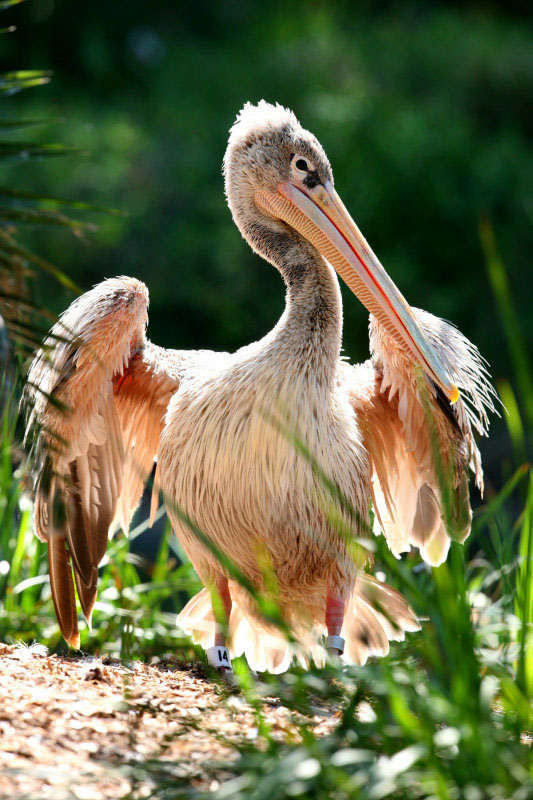|
| 질의: pelecanus onocrotalus | 결과: 34번째/35 | |
Pelican (Family: Pelecanidae) - wiki
| 제목: | Pelican (Family: Pelecanidae) - wiki
| |

| 해상도: 533x800
파일크기: 153527 Bytes
촬영일: 2007:03:27 20:03:38
등록시간: 2007:08:20 08:09:41
|
Pelican
From Wikipedia, the free encyclopedia
[Photo] Pink-backed Pelican (Pelecanus rufescens). San Diego Wild Animal Park Canon EOS 5D, Canon EF 400mm f/2.8L IS USM http://www.pbase.com/ahuse/image/75923093 by Andrew Huse
A pelican is any of several very large water birds with a distinctive pouch under the beak belonging to the bird family Pelecanidae.
Along with the darters, cormorants, gannets, boobies, frigatebirds, and tropicbirds, pelicans make up the order Pelecaniformes. Like other birds in that group, pelicans have all four toes webbed (they are totipalmate). Modern pelicans are found on all continents, except Antarctica. Birds of inland and coastal waters, they are absent from polar regions, the deep ocean, oceanic islands, and inland South America.
Appearance and behavior
Pelicans are large birds with enormous, pouched bills and long wings. The smallest of the pelican is the Brown Pelican (Pelecanus occidentalis), small individuals of which can be as little as 2.75 kg (6 lbs), 106 cm (42 in) and have a wingspan of 1.83 m (6 ft). The largest pelican species is believed to be the Dalmatian Pelican (Pelecanus crispus), at up to 15 kg (33 lbs), 183 cm (72 in) and a maximum wingspan of nearly 3.5 m (11.5 ft).
Pelicans have two primary ways of feeding:
- Group fishing: used by white pelicans all over the world. They will form a line to chase schools of small fish into shallow water, and then simply scoop them up. Large fish are caught with the bill-tip, then tossed up in the air to be caught and slid into the gullet head first.
- Plunge-diving: used almost exclusively by the American Brown Pelican, and rarely by white pelicans like the Peruvian Pelican or the Australian Pelican.
Occasionally, pelicans will consume animals other than fish. In one documented case, a pelican swallowed a live pigeon, and reports of similar incidents have surfaced. In fact, Pelicans are fairly opportunistic predators, and while fish forms the bulk of their diet due to being the most common food source where Pelicans nest, they will quite readily eat any other food that is available to them.
Pelicans are gregarious and nest colonially, the male bringing the material, the female heaping it up to form a simple structure. Pairs are monogamous for a single season but the pair bond extends only to the nesting area; mates are independent away from the nest.
Species
Brown Pelican Pelecanus occidentalis
Peruvian Pelican Pelecanus thagus
American White Pelican Pelecanus erythrorhynchos
Great White Pelican Pelecanus onocrotalus
Dalmatian Pelican Pelecanus crispus
Pink-backed Pelican Pelecanus rufescens
Spot-billed Pelican Pelecanus philippensis
Australian Pelican Pelecanus conspicillatus
From the fossil record, it is known that pelicans have been around for over 40 million years, the earliest fossil Pelecanus being found in early Miocene deposits in France. Prehistoric genera have been named Protopelicanus and Miopelecanus. The supposed Miocene pelican Liptornis from Argentina is a nomen dubium, being based on hitherto indeterminable fragments.
A number of fossil species are also known from the extant genus Pelecanus:
Pelecanus alieus (Late Pliocene of Idaho, USA)
Pelecanus cadimurka
Pelecanus cauleyi
Pelecanus gracilis
Pelecanus halieus
Pelecanus intermedius
Pelecanus odessanus
Pelecanus schreiberi
Pelecanus sivalensis
Pelecanus tirarensis
Symbolism
In medieval Europe, the pelican was thought to be particularly attentive to her young, to the point of providing her own blood when no other food was available. As a result, the pelican became a symbol of the Passion of Jesus and of the Eucharist. It also became a symbol in bestiaries for self-sacrifice, and was used in heraldry ("a pelican in her piety" or "a pelican vulning (wounding) herself"). Another version of this is that the pelican used to kill its young and then resurrect them with its blood, this being analogous to the sacrifice of Jesus. Thus the symbol of the Irish Blood Transfusion Service (IBTS) is a pelican, and for most of its existence the headquarters of the service was located at Pelican House in Dublin, Ireland.
For example, the emblems of both Corpus Christi College, Cambridge and Corpus Christi College, Oxford are pelicans, showing its use as a medieval Christian symbol {'Corpus Christi' - 'body of Christ'}.
This legend may have arisen because the pelican used to suffer from a disease that left a red mark on its chest. Alternatively it may be that pelicans look as if they are doing that as they often press their bill into their chest to fully empty their pouch.
The symbol is used today on the Louisiana state flag and Louisiana state seal, as the Brown pelican is the Louisiana state bird. Likewise, the pelican is featured prominently on the seal of Louisiana State University and St. Paul's School (Concord, New Hampshire). A pelican logo is also used by the Portuguese bank Montepio Geral.
http://en.wikipedia.org/wiki/Pelican
| The text in this page is based on the copyrighted Wikipedia article shown in above URL. It is used under the GNU Free Documentation License. You may redistribute it, verbatim or modified, providing that you comply with the terms of the GFDL. |
|
댓글 |
|---|
| | 손님 |
|
| Pink-backed Pelican (Pelecanus rufescens) is a member of the pelican family of birds. It is a resident breeder in Africa, southern Arabia and Madagascar in swamps and shallow lakes. The nest is a large heap of sticks, into which 2-3 large white eggs are laid. The chicks feed by plunging their heads deep into the adult’s pouch and taking the partially digested regurgitated fish. |
| | 손님 |
|
| pelicans |

|

|

|
pelecanus onocrotalus
34/35 |

|
 |
^o^
동물그림창고 똑똑전화 누리집
^o^
|
|
|